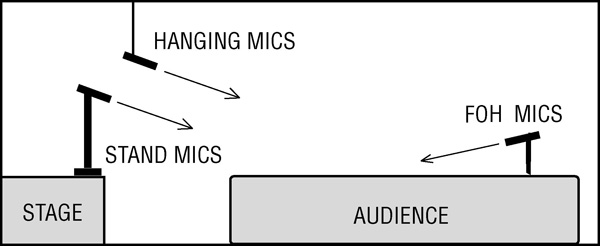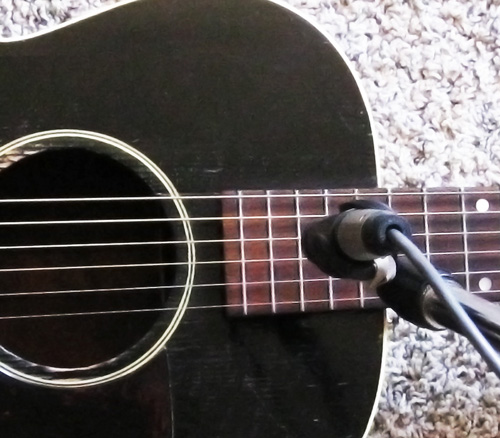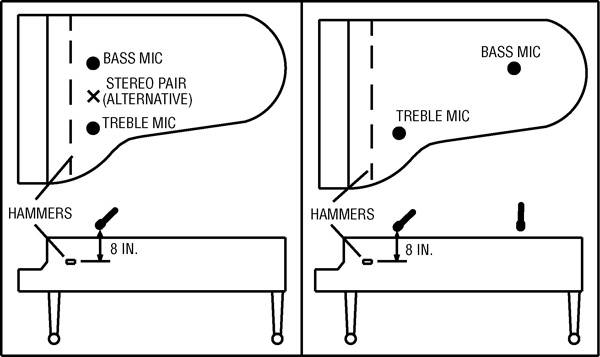
Laundry List
As always, there is no one “right” way to mic voices and instrument for live recording purposes – or any other application for that matter. The suggestions here are techniques that have been proven to work, but never hesitate to use what feels best for your situation.
Vocal. It’s usually best to stick with a cardioid dynamic or condenser, maybe with a presence peak around 5 kHz, and perhaps with a foam windscreen to reduce breath pops. Lips should touch the grille/foam for best isolation. Aim the rear of the mic at stage monitors to reduce monitor pickup and feedback.
Also, try using a 100 Hz low-cut filter and some low-frequency roll-off to reduce pops and to compensate for proximity effect.
If more isolation and gain-before-feedback is needed, try a hypercardioid model such as an Audix OM7 and aim the mic horizontally.

Acoustic guitar. Consider using a cardioid condenser positioned about 3 inches to the neck side of the sound hole, a few inches away (Figure 1). Roll off excess bass. Aim the mic downward to pick up less vocal.
Another approach is a direct box on the guitar pickup. In addition, some mini mics are specially designed to clip onto a guitar. And, taking the feed via DI box is another possibility.
Electric guitar. To add some guitar amp distortion, mike the amp about 1 inch from its speaker cone, slightly off center, with a cardioid dynamic model. A leakage-free alternative is to use a DI box and process the signal during mixdown through a guitar-amp modeling processor or plug-in.
Electric bass, synthesizer, drum machine. Go with a DI box.
Leslie organ speaker. Place a cardioid dynamic with a presence peak a few inches from the top louvers, then add another mic on the lower bass speaker.

Grand piano. Tape a mini or boundary mic to the underside of the raised lid in the middle. For stereo, use two mics: one over the bass strings and one over the treble strings. For more isolation, close the lid and tweak EQ to remove the tubby coloration (usually cut around 125 Hz to 300 Hz).
Or, raise or remove the lid. Place two flat condensers 8 inches over the bass and treble strings, about 8 inches horizontally from the hammers, aiming at them (Figure 2). One other approach is to put the bass mic about 2 feet nearer the tail, aiming at the sound board.
Upright piano. Place two cardioids facing the sound board, a few inches away, dividing the piano in thirds.
Drums (toms/snare). Place a cardioid dynamic with a presence peak – or a clip-on cardioid condenser – about an inch above the head and 1-2 inches in from the rim, angled down about 45 degrees to the head.
Drums (cymbals). Using one or two boom stands, place cardioid condensers (flat or rising high-frequency response) 2 to 3 feet over the cymbals. The mics can be spaced 2 to 3 feet apart or mounted “XY” style for mono-compatible recording. A stereo mic can also be used effectively.
